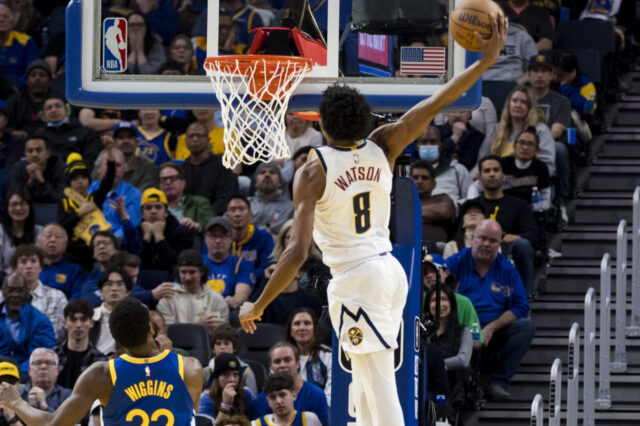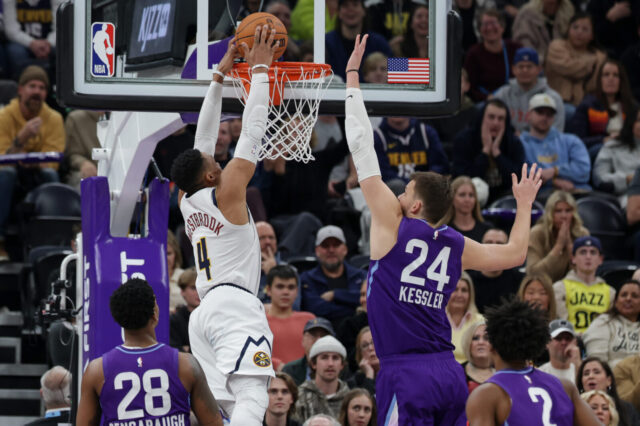Expectations for Jamal Murray were sky high heading into 2020-21. After a breakout performance in the bubble just 10 months ago, Murray was set to take the next step in his career and prove he belonged among the NBA’s elite guards. ESPN even jumped him from #40 to #22 in its ranking of Top 100 players of 2020 – imagine that!
Though Murray wasn’t lighting the nets on fire quite in the same fashion as in Disney World, he still put forth a much improved year and was a key reason the Nuggets were successful.
Unfortunately, things took a turn for the worse when his knee buckled late on April 12 at Golden State. Season over.
Jamal Murray 2020-21 per game stats
| Games | Minutes | Points | Rebounds | Assists | Turnovers | 2-point % | 3-point % |
|---|---|---|---|---|---|---|---|
| 48 | 35.5 | 21.2 | 4.0/td> | 4.8 | 2.3 | 52.3 | 40.8 |
What Happened
It looked like the bubble magic wore off quick for Murray when on opening night he had a nine-point dud in a horrible loss to Sacramento, but Jamal soon shook off the rust and returned to form. He put up 50 against Cleveland in February, and though he wasn’t ever in contention for an All-Star slot in the ultra-competitive Western Conference, by the time Aaron Gordon came Murray had the Nuggets looking like the best team in the league.
Then, the worst case scenario happened. Murray tore his ACL on April 12 and just like that Denver’s realistic championship aspirations went up in smoke. Now, his season will only be remembered for the ACL injury which is a shame because he was having a career year.
Best Moment — 50 point game against Cleveland
On February 19, Murray had one of the best single-game performances in NBA history when he dropped 50 against the Cavaliers. While any 50-point game is impressive, Jamal did it in such a way that had never happened before: he shot zero free throws, becoming the first player to score 50 without going to the line. Instead, Murray got there by finishing 21-25 from the field and 8-10 from three, good for 84.0% overall. Only Wilt Chamberlain has had a 50-point game with a higher FG%, back in 1967. How ridiculous is that?
Player Grade — Incomplete
To many, Jamal severely underperformed this season compared to his bubble standards. I disagree. Though his 21.2 points per game were well under the 26.5 he averaged in Orlando, they were still a career high. He shot the best of his career from three this season. In the 48 games he played, he scored 20+ points in 30 of them, including a stretch where he did so 12 consecutive times. Just because he wasn’t dropping 40 or 50 every night doesn’t mean he didn’t have a good season or that he is a “bubble fraud.”
The real travesty is that we didn’t get to see Murray in the postseason. Donovan Mitchell averaged 32.3 in his playoff run; there is no reason to think Jamal couldn’t have been in the same range while giving the Nuggets a legitimate shot at the title. For any inconsistencies he may have in the regular season, Murray more than makes up for it when it matters. For that reason, he gets a pass on being graded. Without that crucial playoff data, it doesn’t seem fair to grade his season overall.
Offseason Outlook
Jamal Murray has one goal this offseason: get healthy. It’s easily the most important thing he can do, and frankly, the only thing he should worry about. His contract is locked in. Now he just needs to heal his knee, rehab, and stay in shape the best he can. We already know he won’t be available to start the season and with an injury as serious as an ACL there’s no rush for him to get back.
In the long run, a full recovery will pay more dividends both for Murray and the Nuggets than if he tries to come back too soon and reaggravates it or gets hurt again. It sucks because Jamal is one of the most competitive players in the league, and undoubtedly it hurt him to have to watch the playoffs from the sidelines, but he needs to be patient with it. The Nuggets can survive most of the regular season without him, but for an aspirational playoff run next year Jamal needs to be at or close to 100%.


